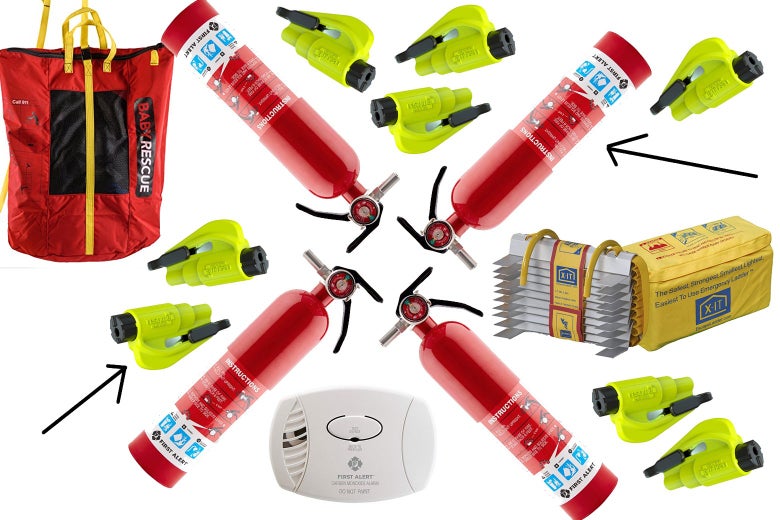
Photo illustration by Slate. Photos by First Alert, X-IT, Baby Rescue, and Resqme.
The worst time to realize you need a piece of emergency equipment is when you are in the middle of an emergency. Buying detectors and escape gear isn’t fun, but it is part of being an adult human tasked with keeping oneself, loved ones, and pets alive. This is by no means a comprehensive list of stuff you need to have around—for that check out the National Safety Council—but rather stuff that our own staff has found a little too easy to overlook in the past. (Fortunately, not to the point of disaster.)
When a carbon monoxide detector started screeching in my college group house, my roommates and I were confused—we’d never noticed the little white box before. Later, a firefighter who responded to our 911 call told us we were lucky our landlord had installed one. “You’ve got a lot of CO in there,” she told us, grimly, of the odorless, colorless, poisonous gas that was spreading through our home due to a furnace malfunction.
Had we gone to bed that night with no alarm to warn us, we might have gotten sick or worse. About 50,000 people visit a U.S. emergency room each year due to accidental carbon monoxide poisoning; at least 430 people die. At under $20, a plug-in detector with a battery backup is too cheap—and possibly life-saving—to justify going without. —Christina Cauterucci
According to the National Fire Protection Association, working smoke detectors (you already have those, right?) and a fire evacuation plan are the best ways to ensure your safety in case of a fire. Take a look at NFPA’s useful guide to escape planning, which suggests that you walk through your house in advance, map out exits, and ensure that there is more than one way out of every room. If you have a house with more than one level, this may mean that you should consider buying a fire ladder to provide an additional escape route. Children can practice using the ladder with adults to be certain that they can do it correctly, quickly, and independently if the need arises. If you have an infant, you may want to purchase a baby rescue bag, made from flame retardant nylon with a tether, which allows you to lower your child to safety. —Cleo Levin
Years ago I had a very small fire in my apartment, which my husband thankfully had the presence of mind to put out with a fire extinguisher procured from our building’s hallway. Since then I’ve become a sort of fire extinguisher evangelist, as that small piece of equipment saved us from a much larger and more dangerous blaze. As noted above, when it comes to fire safety, smoke alarms and evacuation plans should be your first line of defense, but every home should have one or more fire extinguishers too. NFPA has good tips on how and when to use one (if it’s a small, containable fire, for instance, or if you need to momentarily keep flames at bay for an escape). NFPA’s Susan McKelvey says you should only purchase a fire extinguisher that’s been certified by a third-party safety-testing organization like UL, which is indicated with a UL mark on the product itself, as well as in the product description if you buy it online. —Jill Pellettieri
Here’s a fun little bit of nightmare fuel: You’re trapped in a car that’s sinking into water, and you can’t open a window to get out. Or your child is playing with a seatbelt that gets locked around his neck—the more he tries to wriggle out, the tighter the seatbelt becomes. These scenarios are why gadgets like the Resqme Original Keychain Car Escape Tool exist. This gizmo features two tools in one—a spring-loaded metal cone that you press into a window to break the glass, along with a recessed blade to cut away a seatbelt. Other vehicle escape tools have additional functions like USB chargers and flashlights, but a small one like the Resqme is easier to keep close by, on your keychain or in the console of your car.
In a 2019 report on vehicle escape tools that recommended small, spring-loaded versions like the Resqme, AAA reminds drivers to determine whether the side windows in your car are made with tempered or laminated glass. Laminated glass, which is standard for windshields and increasingly used in side windows in newer vehicle models, is much better at preventing occupant ejection in a crash—which is why carmakers use it. But zero vehicle escape tools that AAA tested were at all effective at breaking it. Take the time to find out which tempered windows to target for escape in your vehicle before you’re in a dangerous situation. (AAA explains how in the summary recommendations of its report.) Knowledge, after all, is power! —Rebecca Onion
Slate has relationships with various online retailers. If you buy something through our links, Slate may earn an affiliate commission. We update links when possible, but note that deals can expire and all prices are subject to change. All prices were up to date at the time of publication.
from Slate Magazine https://ift.tt/36joHip
via IFTTT
沒有留言:
張貼留言